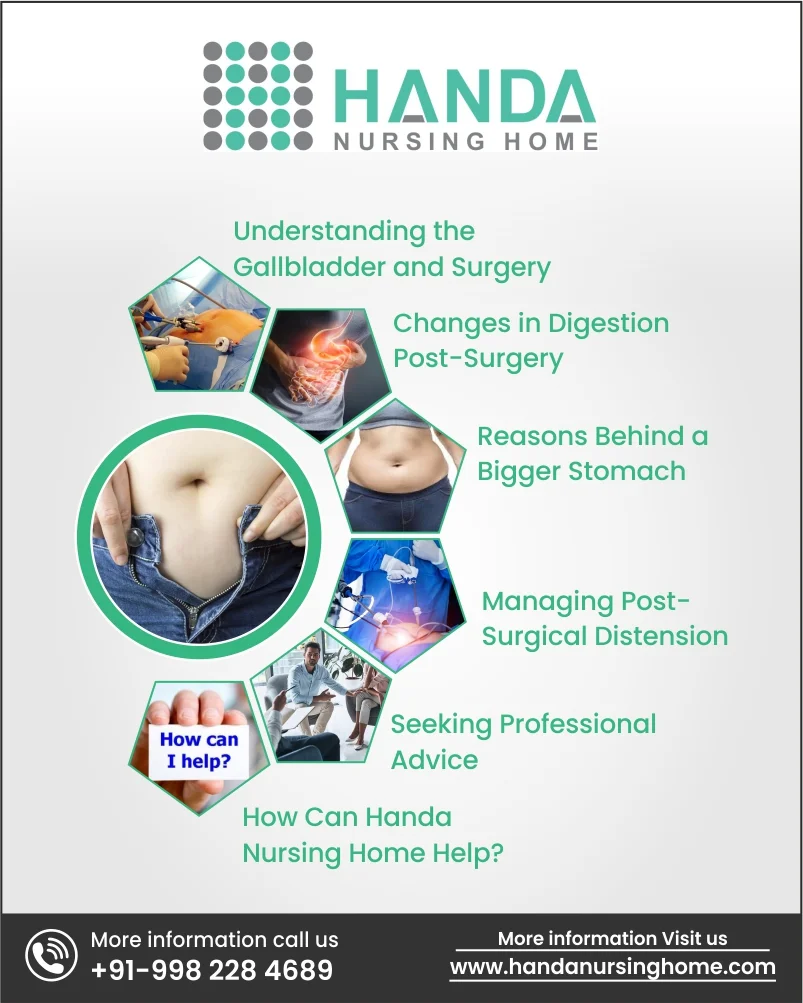The journey of recovery after gallbladder surgery is often met with relief and anticipation for improved health. However, a common concern that may catch many by surprise is the post-surgical distension of the stomach. If you find yourself wondering, “Why is my stomach bigger after gallbladder surgery?” you’re not alone. In this blog, we’ll unravel the mystery behind this phenomenon, offering insights into the reasons and practical strategies to manage it. Understanding the causes behind post-surgical stomach distension is crucial for a smoother recovery.
Understanding the Gallbladder and Surgery
To comprehend why stomach distension occurs post-gallbladder surgery, let’s first explore the gallbladder’s role in digestion. This small, pear-shaped organ plays a crucial role in storing bile, a fluid produced by the liver essential for breaking down fats during digestion.
Gallbladder surgery becomes necessary when issues like stones, tumors, inflammation, or infections compromise its function. The surgery, while relieving patients of these health concerns, introduces changes to the digestive process. It’s important to recognize that gallbladder removal is a positive step towards overall health, despite the unexpected issue of stomach distension. Understanding the “gallbladder removal benefit” involves acknowledging the relief from potential complications and promoting long-term well-being.
Changes in Digestion Post-Surgery
Gallbladder removal triggers adjustments in digestion as the body adapts to the absence of this organ. The gallbladder is responsible for releasing bile in response to food consumption, aiding in the breakdown of fats. Post-surgery, the body relies on continuous bile production from the liver, leading to changes in bile flow and fat metabolism.
Understanding these changes is paramount, especially when considering factors like gallbladder surgery recovery time. The body needs time to recalibrate its digestive processes, and during this transition, some individuals may experience a temporary increase in stomach size.

Reasons Behind a Bigger Stomach
After gallbladder removal surgery, various factors contribute to stomach enlargement. Understanding these aspects is vital for postoperative well-being
Remaining Scar Tissues
After gallbladder surgery, the emergence of scar tissues is a potential contributor to abdominal enlargement. Surgeons employ meticulous techniques to minimize such scarring, understanding the delicate nature of the tissues involved. Individuals must be attuned to signals such as cramps, constipation, or nausea, as these could signify the presence of residual scar tissues. This underscores the importance of post-surgical vigilance and prompt communication with healthcare providers to address any emerging concerns.
Dietary Adjustments
A poorly balanced diet following gallbladder surgery can contribute to an expanded stomach, highlighting a direct correlation between dietary habits and ensuing issues. Overlooking the significance of a balanced post-surgery diet may result in the accumulation of abdominal fat, increased bloating, and bouts of constipation. With the altered fat processing dynamics in the absence of the gallbladder, dietary choices play a crucial role in influencing digestive comfort.
Continuous Bile Production
After gallbladder removal, the dynamics of bile flow undergo a significant shift. Without the gallbladder to store and release bile as needed, there’s a continuous stream of this digestive fluid into the small intestine. The surplus of bile in the small intestine contributes to bloating, creating the visual impression of a larger stomach. To maintain digestive balance post-surgery, it becomes crucial to navigate this altered bile flow. This involves embracing dietary adjustments, prioritizing smaller, nutrient-rich meals, and paying attention to the body’s response.
Temporary Post-Surgical Inflammation
After surgery, the body undergoes a natural inflammatory response as part of the healing process. This temporary inflammation can contribute to a noticeable increase in stomach size. The body’s immune system, triggered by the surgical intervention, releases inflammatory chemicals. This process leads to fluid retention and localized swelling around the surgical site, including the abdominal region. While this temporary increase in stomach size may cause concern, it’s essential to recognize it as a typical part of the healing journey.
Fluid Retention
After surgery, fluid retention is a potential factor contributing to a temporarily larger stomach. This occurrence is linked to the body’s natural response to the healing process. Excess fluids, often retained due to the trauma of surgery, can accumulate in the abdominal area, leading to temporary bloating and an enlarged stomach. While it may be disconcerting, understanding that this is a common aspect of post-surgical recovery can provide reassurance.
Abdominal Muscle Weakness
Surgery exerts considerable strain on abdominal muscles, a fact often underestimated in the postoperative journey. The strain results in weakened abdominal muscles, a factor that significantly influences the appearance of stomach distension. As these muscles undergo stress during the surgical process, their diminished strength can contribute to a subtle but noticeable change in the contour of the abdomen. Understanding the impact of weakened muscles on the post-surgical physique emphasizes the importance of gradual muscle recovery.
Managing Post-Surgical Distension
Now that we’ve explored the various factors contributing to post-surgical stomach distension, let’s focus on practical strategies to alleviate these concerns.
Regular Exercise
Engaging in daily physical activity is crucial for maintaining overall health and aiding post-surgical recovery. Simple exercises like walking can enhance blood circulation, stimulate fat breakdown, and contribute to a more comfortable recovery.
Healthy Eating
A balanced and mindful approach to eating plays a pivotal role in managing post-surgical stomach concerns. Avoiding certain foods known to cause bloating and discomfort is essential. Opting for smaller, frequent meals instead of larger portions aids in digestion and prevents overloading the digestive system.
Hydration
Water, often underestimated, plays a crucial role in post-surgical recovery. It acts as a natural detoxifier, flushing excess bile from the system and maintaining overall health. Staying adequately hydrated supports digestion, prevents constipation, and contributes to the body’s ability to adapt to post-surgical changes.
Incorporating these simple yet impactful strategies empowers individuals to actively participate in their recovery, promoting a sense of well-being and confidence in the healing process.
Seeking Professional Advice
While self-care strategies are valuable, seeking professional advice is equally important, especially considering the long-term benefit of gallbladder removal. Regular check-ups and open communication with healthcare providers ensure personalized guidance tailored to your recovery journey. Knowing when to seek medical attention for persistent or severe symptoms is crucial for proactive and effective management.
How Can Handa Nursing Home Help?
At Handa Nursing Home, we understand the unique challenges of post-gallbladder surgery recovery. Our compassionate healthcare professionals are committed to providing personalized support and guiding you through every step of your journey. From addressing concerns about female gallbladder surgery recovery time to navigating problems after gallbladder removal, our team offers expertise and care tailored to your specific needs. Your well-being is our priority, and we’re here to ensure you receive the best possible care. Take the next step towards optimal health – reach out to Handa Nursing Home today for compassionate support and a dedicated approach to your recovery.

